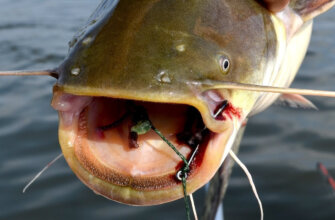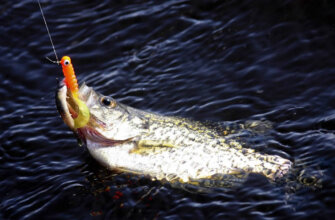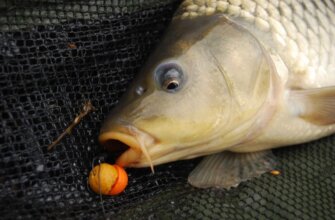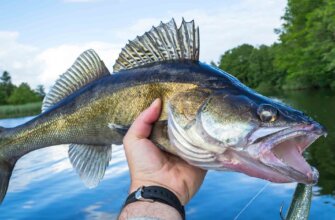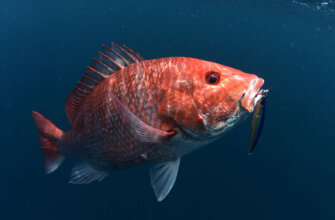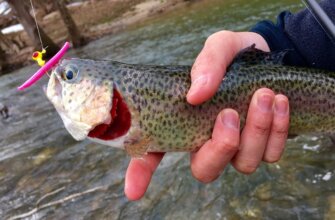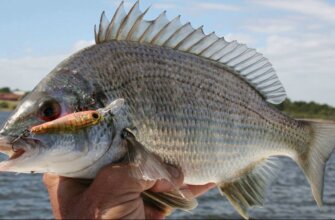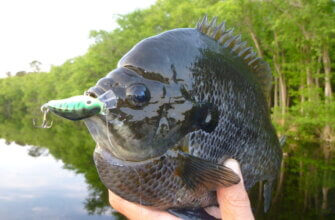When it comes to bass fishing, choosing the right bait can significantly impact your success on the water. There are various types of bait that work well for bass fishing, and the choice often depends on the fishing conditions, time of year, and the behavior of the bass in the specific body of water you’re fishing in.
10 best bait for bass
Here are 10 popular and effective baits for bass fishing:
- Plastic Worms. Soft plastic worms, such as Senkos or Zoom Trick Worms, are versatile and can be rigged in different ways to imitate various types of prey.
- Jigs. Bass jigs, with a lead head and a skirt, can be tipped with a trailer like a crawfish or a plastic chunk to mimic a prey item that bass often feed on.
- Crankbaits. These hard-bodied lures come in various sizes and shapes and imitate baitfish. They are designed to dive and create a wobbling action to attract bass.
- Spinnerbaits. Spinnerbaits have a metal blade that spins as it moves through the water, creating vibrations and flash that can trigger a bass’s predatory instinct.
- Topwater Lures. These lures float on the surface of the water and create commotion when retrieved, imitating injured prey. Examples include poppers, buzzbaits, and frogs.
- Swimbaits. These lures imitate the swimming action of baitfish. They can be either soft plastic or hard-bodied and are often used for targeting larger bass.
- Jerkbaits. Jerkbaits are long, slender lures that resemble baitfish. They are designed to be twitched and paused during retrieval to mimic an injured fish.
- Texas Rigs. This is a popular rigging technique where a soft plastic bait, such as a creature bait or a lizard, is rigged weedless with a bullet-shaped weight and a hook.
- Creature Baits. These soft plastic baits have unique shapes and appendages, imitating creatures like crawfish or lizards. They work well in situations where bass are feeding on these types of prey.
- Flipping and Pitching Baits. Flipping and pitching involve making short, accurate casts to specific targets like heavy cover or structure. Baits like beaver-style creature baits or jigs are commonly used for this technique.
Plastic Worms
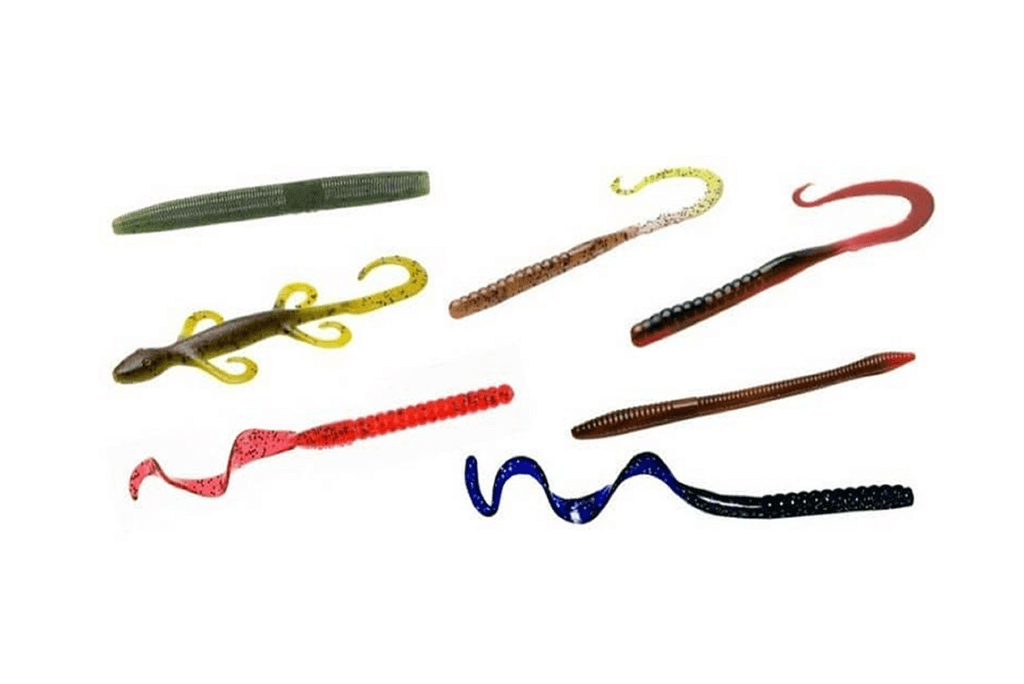
Plastic worms are one of the most popular and effective lures for bass fishing. They come in a variety of sizes, colors, and styles, allowing anglers to adapt to different fishing conditions and bass behavior. Here are some key points to consider when using plastic worms for bass fishing:
- Types of Plastic Worms: There are several types of plastic worms available, including straight-tail worms, curly-tail worms, ribbon-tail worms, and creature baits. Each type has its own unique action and can be effective in different situations.
- Worm Length: The length of the worm can vary from a few inches to over a foot. Generally, shorter worms are better suited for finesse fishing and clear water conditions, while longer worms are often used in deeper water or when targeting larger bass.
- Worm Color: The color of the worm is an important consideration. Bass can be attracted to a variety of colors depending on the water clarity and light conditions. In clearer water, natural colors like green pumpkin, watermelon, or brown can be effective. In stained or murky water, brighter colors like chartreuse, red, or black can work well.
- Rigging Options: Plastic worms can be rigged in different ways, including Texas rigging, Carolina rigging, wacky rigging, or weightless rigging. Each rigging technique offers its own advantages and allows you to present the worm differently to the bass.
- Techniques: There are various techniques you can use when fishing with plastic worms. Some popular techniques include dragging the worm along the bottom, hopping or shaking it, slow-rolling it, or working it through cover like weeds or brush. Experiment with different retrieves to find what works best in your fishing location.
- Consider the Conditions: The weather, water temperature, and time of year can influence bass behavior and their preference for certain types of plastic worms. Adjust your lure selection, color, and presentation based on these factors.
- Experiment and Observe: Bass fishing can be a trial-and-error process. If you’re not getting bites, try different sizes, colors, and techniques until you find what the bass are responding to. Pay attention to any patterns or cues that may help you refine your approach.
Jigs
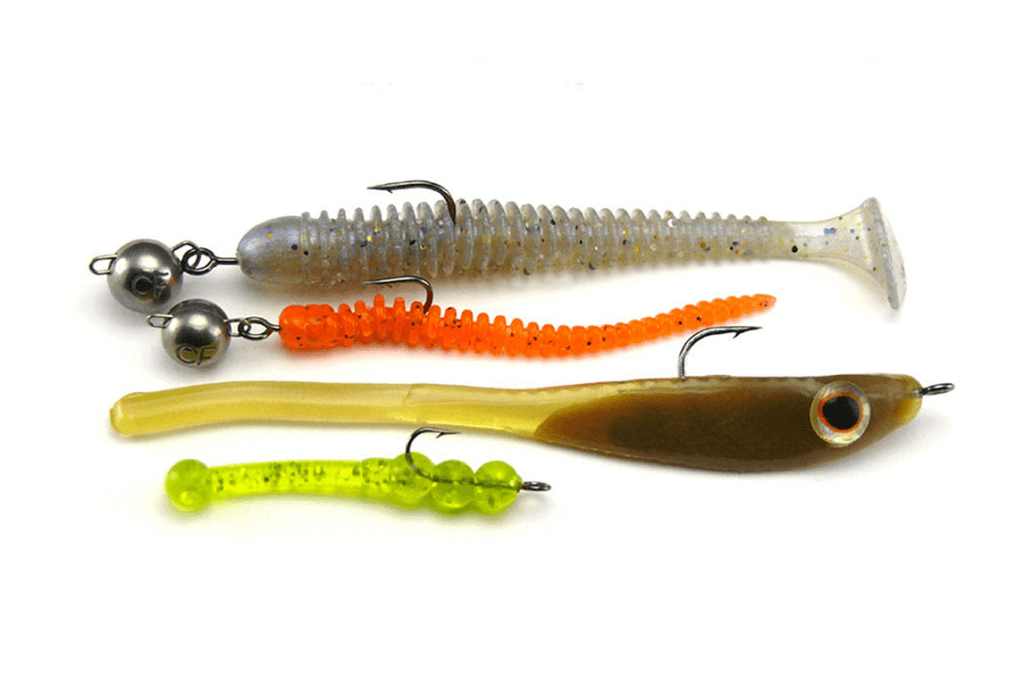
Jigs are a versatile and popular lure choice for bass fishing. They imitate a variety of prey, such as crawfish, baitfish, and even small mammals. Here are a few popular jig types used for bass fishing:
- Football Jig: This jig features a head shaped like a football and is great for fishing on rocky or gravel bottoms. The flat bottom helps it stay upright and avoid snagging. It’s particularly effective for deep-water fishing and dragging along the bottom.
- Flipping Jig: Flipping jigs are designed for flipping and pitching techniques, where you target specific cover or structure close to the shore. They usually have a bullet-shaped head with a weed guard to minimize snagging in heavy cover. Flipping jigs are often paired with a trailer (e.g., crawfish or creature bait) for added attraction.
- Swim Jig: Swim jigs are designed to be retrieved at a moderate to fast pace, imitating a swimming baitfish. They have a streamlined head and a skirted body. The weed guard is typically lighter than that of a flipping jig, allowing for better swimming action. Swim jigs work well in open water or around vegetation.
- Finesse Jig: Finesse jigs are smaller and more subtle than traditional jigs. They work well in clear water or when bass are less aggressive. Finesse jigs usually have a finesse-style skirt, a smaller profile, and a lighter weed guard. They are often paired with a smaller trailer, such as a finesse worm or a grub.
- Casting Jig: Casting jigs are all-around jigs that can be used in various situations. They have a round or semi-round head and are suitable for casting and retrieving. They work well around cover, structure, or when fishing in shallow water. Casting jigs come in different weights, allowing you to adjust the depth and speed of your retrieve.
Crankbaits
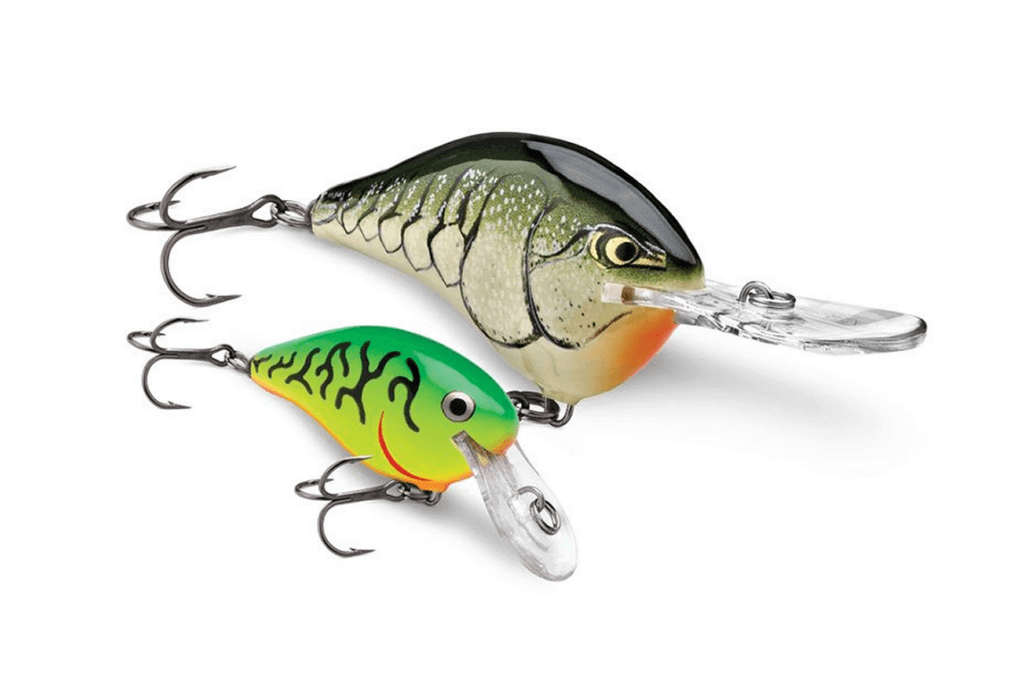
Crankbaits are a popular type of lure for bass fishing, as they imitate injured baitfish and can be very effective at triggering strikes. When selecting crankbaits for bass fishing, consider the following factors:
- Size and Depth: Crankbaits come in various sizes, typically measured by their length and diving depth. Choose a size and diving depth based on the specific fishing conditions, such as water depth and clarity, and the depth at which you want to target bass.
- Lip Design: Crankbaits have different lip designs that affect their diving depth and action. Shallow-diving crankbaits have smaller lips and are ideal for fishing in shallow water or around cover. Deep-diving crankbaits have larger lips that allow them to dive deeper, making them suitable for fishing deeper structures.
- Action: Crankbaits have different swimming actions, including tight wobble, wide wobble, and erratic action. The action can influence how bass react to the lure. Experiment with different actions to determine what the bass are responding to on a given day.
- Color: Bass can be selective about lure color based on water conditions and forage preferences. Consider using natural colors like shad or crayfish imitations in clear water and brighter colors like chartreuse or firetiger in stained or murky water. It’s also beneficial to carry a variety of colors to adapt to changing conditions.
- Retrieve Speed: Vary your retrieve speed to determine what the bass are responding to. Slow and steady retrieves are commonly used, but sometimes a faster or erratic retrieve can trigger strikes. Experiment with different speeds until you find what works best.
- Rattles: Crankbaits may have internal rattles that produce sound and vibrations, which can help attract bass. Choose crankbaits with rattles in situations where you want to create additional noise and draw attention to the lure.
Spinnerbaits
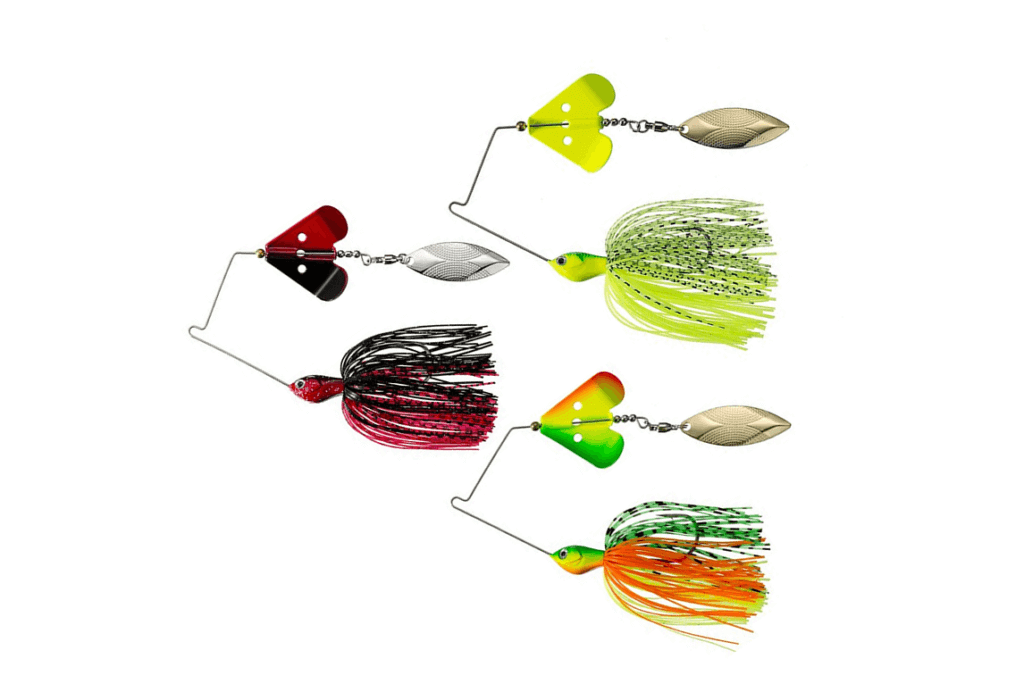
Spinnerbaits are popular lures used for bass fishing. They consist of a metal wire frame with one or more spinning blades attached to it, along with a skirt made of rubber, silicone, or other materials. The blades create flash and vibration in the water, mimicking the movement of a small fish or a fleeing baitfish, which attracts predatory bass.
When selecting spinnerbaits for bass fishing, consider the following factors:
- Blade Type: Spinnerbaits come with different blade types, including Colorado, Willowleaf, Indiana, and Oklahoma blades. Colorado blades create more water displacement and vibration, making them effective in stained or murky water. Willowleaf blades provide more flash and are better suited for clear water conditions. Indiana blades offer a balance between flash and vibration, while Oklahoma blades are larger and create a lot of vibration.
- Blade Color: The color of the blades can make a difference, especially in different water and light conditions. Bright, reflective blades like silver and gold work well in clear water, while darker colors like black and chartreuse are more suitable for stained or muddy water.
- Skirt Material and Color: The skirt of the spinnerbait can be made of silicone, rubber, or other materials. It adds bulk and lifelike movement to the lure. Choose skirt colors that imitate the natural prey of bass, such as shad, bluegill, or crawfish. Popular colors include white, chartreuse, black/blue, and natural green.
- Weight and Size: Spinnerbaits come in various weights and sizes. Choose the weight based on the depth you plan to fish and the speed of your retrieve. Heavier spinnerbaits are better for deeper water and faster retrieves. Smaller spinnerbaits are more suitable for shallow water or when bass are feeding on smaller baitfish.
- Trailer Hooks: Some spinnerbaits come with an additional hook attached to the main hook, known as a trailer hook. This increases your chances of hooking a fish, especially if they are striking short or missing the main hook.
Topwater Lures
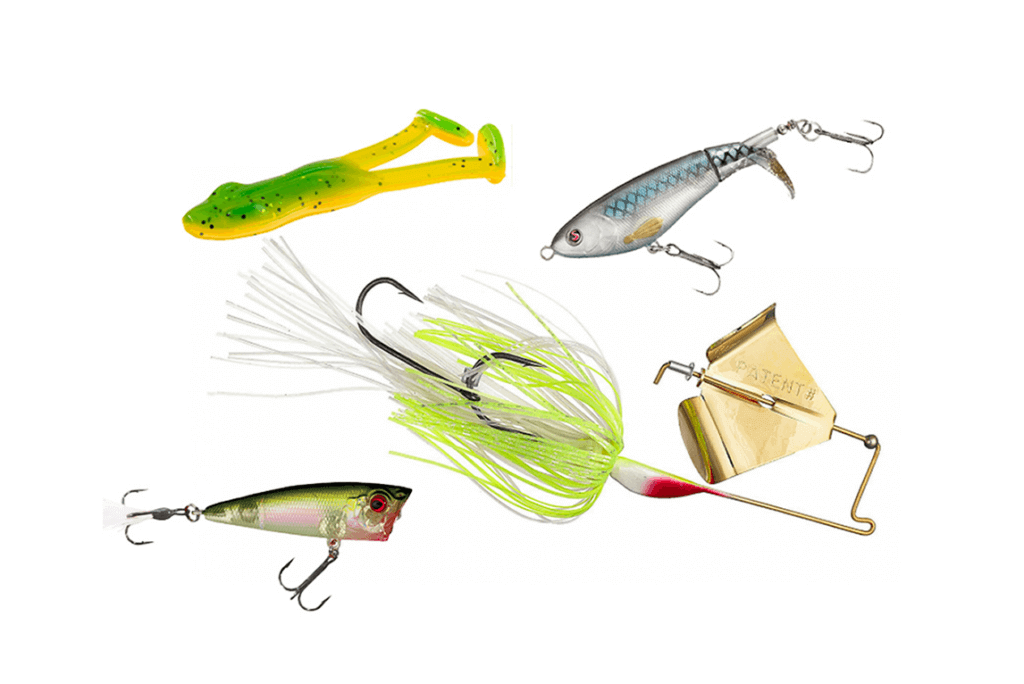
Topwater lures are thrilling and effective for bass fishing, often generating explosive strikes. These lures are designed to imitate prey species that are found on or just below the water’s surface.
Here are some popular topwater lures that are commonly used for bass fishing:
- Popper: A popper is a classic topwater lure with a concave face that creates a popping sound when twitched or jerked. It imitates a wounded baitfish or insect struggling on the surface, which can trigger aggressive strikes from bass.
- Buzzbait: Buzzbaits are designed to create a commotion on the water’s surface with a rotating blade that produces a buzzing sound. This lure is great for covering water quickly and can entice big bass to strike.
- Walking Bait/Walk-the-Dog: Walking baits, such as the Zara Spook or Heddon Super Spook, are long, slender lures that “walk” back and forth when retrieved. This side-to-side action mimics a wounded baitfish and can be very effective, especially in calm water conditions.
- Frog: Frog lures are designed to imitate frogs or other small creatures that swim on the water’s surface. They usually have weedless hooks to allow for fishing in dense vegetation. When worked properly, frog lures can create a realistic action and provoke aggressive strikes from bass hiding in the weeds.
- Propeller Baits: Prop baits have one or more spinning blades attached to them, which create a splashing or buzzing sound as they move across the surface. The spinning blades mimic fleeing baitfish or insects and can be highly effective in drawing bass to strike.
- Pencil Popper: Pencil poppers are long, slim lures with a cylindrical shape and a concave face. When retrieved with a twitching motion, they create a loud popping sound and leave a prominent bubble trail behind. Pencil poppers are particularly effective when targeting larger bass in saltwater or freshwater.
Swimbaits
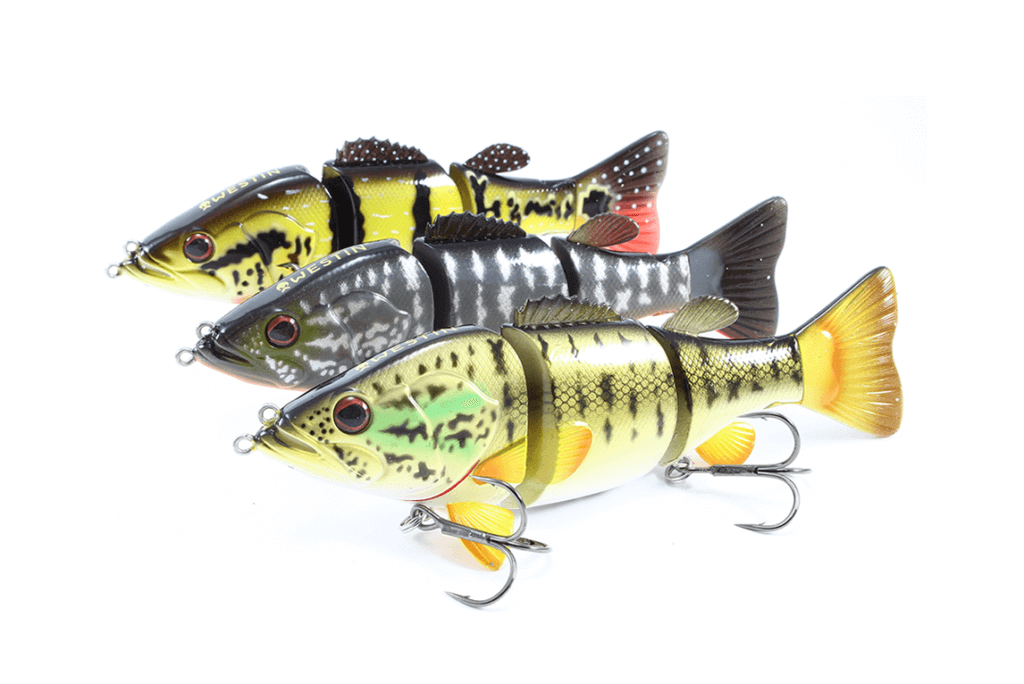
Swimbaits are highly effective lures for bass fishing, particularly for targeting larger bass. They imitate natural baitfish and can be retrieved at various speeds and depths to entice bass to strike. Here are some important things to consider when selecting and fishing swimbaits for bass:
- Types of Swimbaits: There are different types of swimbaits available, including soft plastic swimbaits, paddle tail swimbaits, jointed swimbaits, and glide baits. Soft plastic swimbaits are popular and come in various sizes, shapes, and colors.
- Size and Color: Choose swimbaits that closely resemble the baitfish in the area where you’re fishing. Generally, for larger bass, opt for bigger swimbaits in the 4 to 8-inch range. Common colors include natural shad patterns, silver, white, and chartreuse, but experiment with different colors based on water clarity and conditions.
- Retrieve Speed: Experiment with different retrieve speeds to determine what the bass are responding to on a particular day. Start with a steady retrieve and vary the speed until you find what works. Sometimes a slow, steady retrieve is effective, while other times a faster, erratic retrieve may trigger a strike.
- Depth and Structure: Swimbaits can be fished at various depths depending on the weight and design of the lure. Use heavier swimbaits for deeper water or when fishing around cover such as rocks, submerged trees, or drop-offs. Lighter swimbaits are suitable for shallower water or when fish are actively feeding near the surface.
- Rigging Options: Swimbaits can be rigged in different ways. Some popular rigging options include Texas rigging, weedless rigging, jighead rigging, or using specialized swimbait hooks with weighted or unweighted options. The rigging choice depends on the fishing conditions and the desired action of the bait.
- Location and Season: Consider the time of year and the location you’re fishing. In colder water or during the pre-spawn and post-spawn periods, a slow and subtle presentation may work best. During warmer months or when bass are actively feeding, a faster and more aggressive retrieve can be effective.
- Presentation and Cadence: When retrieving a swimbait, try to mimic the natural swimming action of a baitfish. Vary the retrieve speed, occasionally pausing or twitching the lure to create a more enticing presentation. Experiment with different cadences to trigger reaction strikes.
Jerkbaits
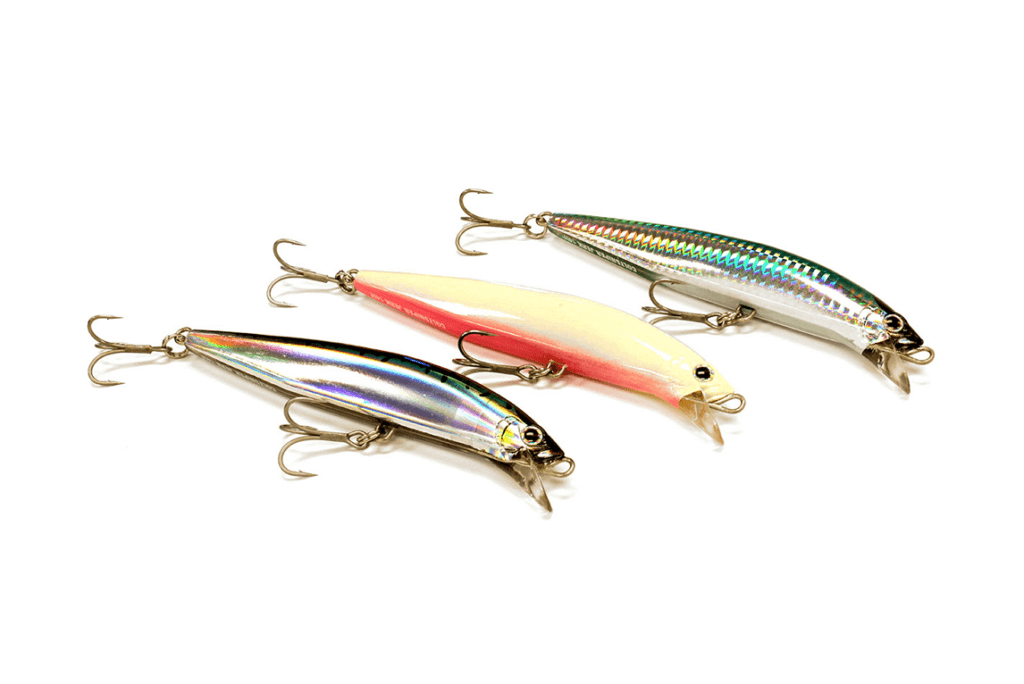
Jerkbaits are popular lures used in bass fishing, particularly in colder water conditions when bass tend to be less active. These lures are designed to imitate injured or dying baitfish, and their erratic action can trigger aggressive strikes from bass. Here are some key points to consider when using jerkbaits for bass fishing:
- Types of Jerkbaits: There are two main types of jerkbaits: hard plastic and soft plastic. Hard plastic jerkbaits typically have a lip that helps create the erratic action, while soft plastic jerkbaits are more flexible and provide a different swimming motion.
- Size and Color: Jerkbaits come in various sizes and colors to match the forage in the water. It’s important to consider the size of the baitfish bass are feeding on and choose a jerkbait that closely resembles them. Natural colors like silver, shad, and bluegill patterns are commonly effective, but experimenting with different colors can sometimes yield better results.
- Action and Cadence: The key to fishing jerkbaits effectively is imparting a lifelike action. The “jerk” in jerkbait refers to the abrupt twitch or snap of the rod tip, followed by a pause. This mimics the injured baitfish struggling to swim. The cadence and length of the pause can vary depending on the bass’s activity level, water temperature, and conditions. Start with a few sharp jerks and experiment with different retrieval speeds and pauses until you find what works.
- Depth Control: Jerkbaits can be fished at different depths by adjusting the line size, weight, and the speed of your retrieve. Floating jerkbaits will rise to the surface when paused, while sinking or suspending models will stay at a certain depth. Experiment with different models and retrieve techniques to cover the water column effectively and find where the bass are holding.
- Location and Presentation: When fishing with jerkbaits, target areas where bass are likely to be holding, such as points, drop-offs, submerged structure, or along the edges of weed beds. Cast the jerkbait past your target and bring it back with the desired action, focusing on imitating an injured baitfish. Vary your retrieval speed and pauses to trigger strikes.
- Cold Water Considerations: Jerkbaits are particularly effective in colder water when bass are less active. In colder temperatures, slow down your presentation and extend the pause between twitches. Bass may be more lethargic and require a slower, more deliberate retrieve to entice a strike.
Texas Rigs
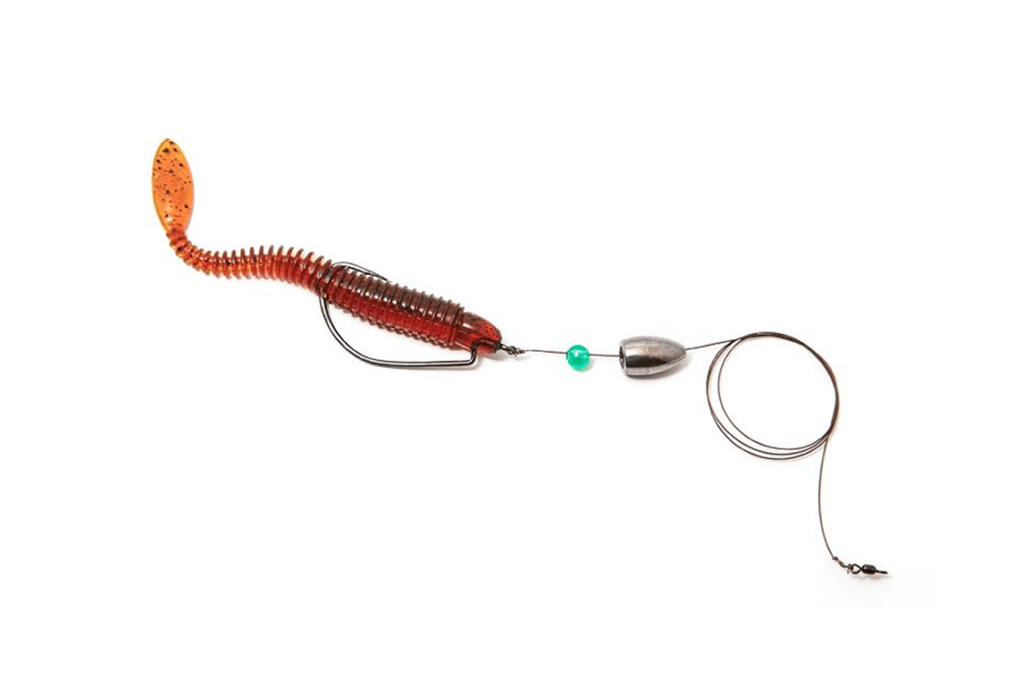
The Texas rig is a versatile and popular setup for bass fishing. It’s known for its weedless presentation and ability to effectively target bass in various types of cover. Here’s how you can rig it:
- Start with a bullet-shaped or slip sinker. The size of the sinker will depend on the depth you’re fishing and the amount of cover present. Heavier sinkers are better for deep water and thick cover.
- Slide the sinker onto your fishing line. If you’re using a bullet-shaped sinker, the narrow end should go first, followed by a plastic or glass bead (optional) to protect the knot from the sinker’s weight.
- Tie a fishing hook to the end of your line. The most commonly used hook for the Texas rig is an offset worm hook. The size of the hook will depend on the size of the bait you’re using.
- Thread the bait onto the hook. For soft plastic baits like worms, creature baits, or crawfish imitations, insert the point of the hook into the head of the bait and push it through until the bend of the hook is concealed. Ensure the bait is straight on the hook, without any twists.
- Optional: Add a plastic worm keeper or a small piece of soft plastic, like a rubber or silicone stopper, to hold the bait in place and prevent it from sliding down the hook.
- Once the bait is secured on the hook, push the point of the hook back into the body of the bait, making it weedless. Ensure the point of the hook is exposed slightly so it can penetrate the bass’s mouth upon striking.
- Texas rig variations: You can experiment with different presentations by modifying the rig slightly. For example, you can use a pegged weight or a split-shot weight instead of a bullet sinker. You can also try using a hook with a screw-lock feature for securing soft plastic baits, or use a wide-gap hook for larger baits.
Creature Baits
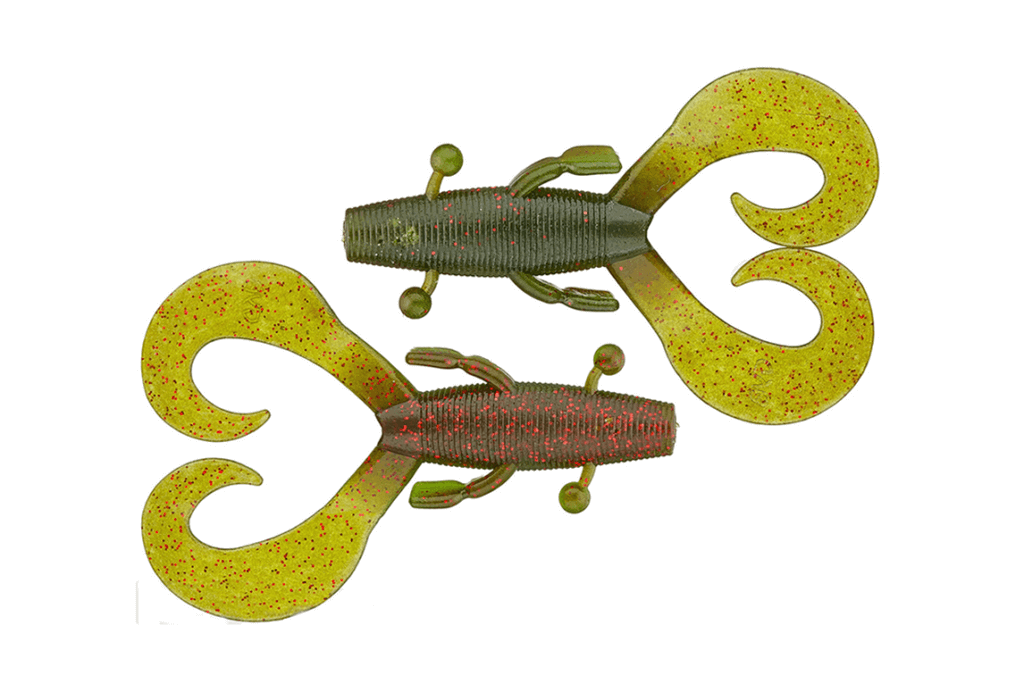
Creature baits are highly effective lures for bass fishing. They imitate various creatures that bass feed on, such as crawfish, lizards, and creatures found in the underwater ecosystem. Here are some popular creature baits used by anglers:
- Soft Plastic Craws: Crawfish are a staple food for bass, and soft plastic craws perfectly imitate these crustaceans. They have multiple legs, pincers, and a bulky body. Craws usually have appendages that produce a lot of action underwater, attracting bass.
- Creature Worms: Creature worms combine the characteristics of worms and creature baits. They have a segmented body with appendages, tentacles, or flappers that create enticing movement. Creature worms often have a thicker profile compared to regular worms, making them stand out.
- Lizards: Soft plastic lizard baits mimic the appearance and movement of lizards. They have a long, slender body with legs and a tapered tail. Lizards are effective in enticing strikes, especially in areas with a lot of vegetation or rocky structures.
- Brush Hogs: Brush hogs are large creature baits with multiple appendages. They have a bulky body with flapping arms and thin tails. The flapping action and water displacement make brush hogs a great choice for flipping and pitching around cover.
- Creature Jigs: Creature jigs combine a jighead with a creature-style trailer. The jighead provides weight and a hook while the trailer adds the creature-like appearance. Creature jigs are versatile and can be fished in a variety of ways, such as flipping, pitching, or dragging along the bottom.
- Beaver-style Baits: Beaver-style creature baits have a compact, bulky body with multiple flapping appendages and a flat tail. These baits create a lot of water disturbance and are effective in heavy cover situations.
- Tube Baits: Tube baits imitate various creatures, such as crayfish or baitfish. They have a hollow, tube-like body with tentacles or appendages. Tube baits are versatile and can be fished with various techniques, including flipping, dragging, or finesse presentations.
Flipping and Pitching Baits
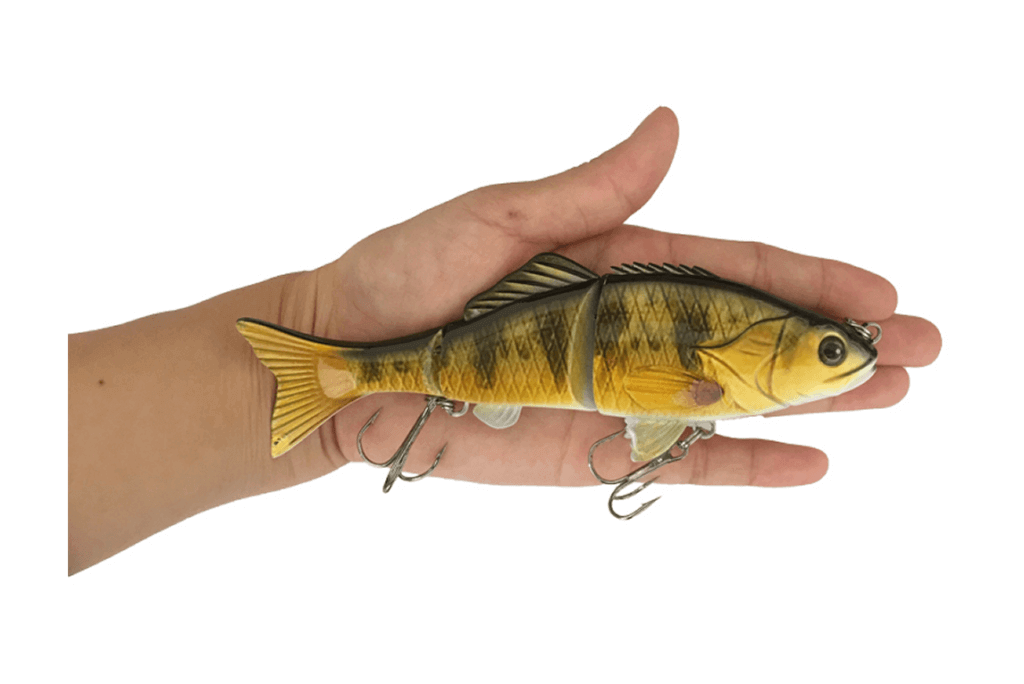
Flipping and pitching are specialized techniques for bass fishing that involve accurate and precise casting of bait into specific targets, such as heavy cover or tight spaces. These techniques are effective for targeting bass in dense vegetation, under docks, around fallen trees, or other hard-to-reach areas where bass seek shelter or ambush prey.
Let explain each technique and provide some tips to help you be successful.
- Flipping: Flipping involves making short, controlled casts directly to a specific target, such as a submerged log, vegetation, or a dock. Here’s how you can do it:
- Equipment: Use a heavy or medium-heavy action baitcasting rod (typically 7 to 8 feet long) paired with a high-capacity reel spooled with a strong fishing line (e.g., 15 to 25-pound test).
- Bait Selection: Choose a bait that works well for flipping, such as a creature bait, jig, or soft plastic bait with a weedless setup.
- Technique: Hold the rod with your dominant hand and release the bait by loosening the reel’s spool with your thumb. As the bait falls, use your non-dominant hand to control the line and prevent backlash. Once the bait reaches the desired depth, engage the reel, and use your rod to impart subtle movements or hops to the bait. Watch for any line movement or subtle taps indicating a bass has taken the bait.
- Presentation: Aim to land the bait as close to the target as possible, ideally letting it drop vertically. Maintain a controlled descent to prevent spooking nearby bass. If you don’t get a bite on the initial drop, slowly lift and drop the bait a few times, mimicking the movements of a prey animal.
- Pitching: Pitching is similar to flipping but involves making longer casts to cover more water while maintaining precision. It’s often used when the target is slightly farther away or when the cover isn’t as dense. Here’s how to pitch effectively:
- Equipment: Use a medium to medium-heavy baitcasting rod (around 6.5 to 7.5 feet) and pair it with a reel and line similar to what you’d use for flipping.
- Bait Selection: Choose a lure that works well for pitching, such as a jig, Texas-rigged soft plastic, or a compact spinnerbait.
- Technique: Hold the rod at a slight angle with your dominant hand and use your non-dominant hand to pull the line from the reel. Keep your thumb lightly on the spool to control the line’s release. Swing the rod forward with a smooth motion, simultaneously releasing the line with your thumb to propel the bait toward the target. Once the bait reaches the water, engage the reel and prepare for a potential strike.
- Presentation: Try to land the bait as close to the target as possible, ideally within a few feet. As the bait sinks, maintain slight tension on the line to detect any bites or changes in movement. If you don’t get a bite on the initial fall, retrieve the bait with short, controlled hops or slow dragging motions, enticing bass in the area.

